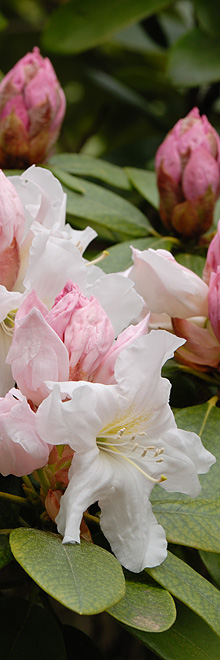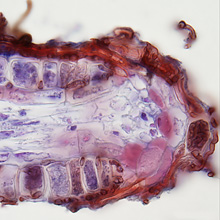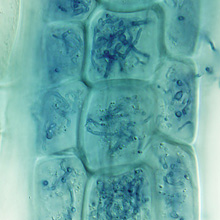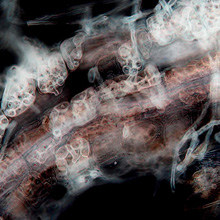Ericoid mycorrhiza
Ericoid mycorrhiza is together with orchid mycorrhiza evolutionarily the youngest and the least understood type of mycorrhizal symbiosis. It is a specific type of endomycorrhiza, occurring in the roots of some members of the Ericaceae family that inhabit in all continents except Antarctica and comprise such diverse growth forms as tropic epiphytes, high-mountain trees, and arctic shrubs. Compared to other mycorrhizal types, it has distinct anatomy, morphology, and ecophysiology as well as the spectrum of fungal and plant partners.
The most apparent characteristic morphological feature of ericoid mycorrhiza are the thin roots of ericoid plants; they are called the hair roots and often have a diameter less than 100 µm. These anatomically very simple ephemeral organs occur in all ericoid mycorrhizal plants and provide an illustrative example of the co-evolution of plant and fungi – while most mycorrhizal plants have enlarged root cortex, this tissue is strongly reduced in the hair roots, which in contrast possess enlarged rhizodermal cells that are the primary site of colonization by fungi. Here, the fungi form the characteristic hyphal coils and loops that serve as exchange points for nutrients and information with the host plant. A limited extraradical mycelium develops from the colonized hair roots into the surrounding substrate but in contrast to other mycorrhizal types, little is known about its functioning.
Ericoid mycorrhizal fungi are relatively diverse and belong to both Ascomycota and Basidiomycota, but most of our knowledge on ericoid mycorrhiza is based on many experiments with just two ascomycetous mycobionts, namely Hyaloscypha hepaticicola and Oidiodendron maius. Both are capable saprobes and especially O. maius can survive in nature long periods without the host plant. They produce several specific enzymes (proteases, chitinases etc.), which enable them to utilize complex organic compounds (peptides, proteins, chitin etc.) as sources of nutrients that would be otherwise non-accessible to non-mycorrhizal plants.
In the Northern Hemisphere’s context, ericaceous plants dominate particular habitats like peat bogs, moorlands, and heathlands. These are characteristic with several factors negatively influencing the dynamics of its plant communities, such as low nutrient accessibility, low pH, high carbon : nitrogen ratio and heavy metal toxicity. It is believed that ericoid mycorrhiza enables ericaceous plants to sustain these environmental stresses and successfully compete with other plants.
Interested readers can find further information about this peculiar symbiosis in a recent review freely available at https://link.springer.com/article/10.1007/s00572-020-00989-1.



